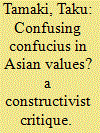| Srl | Item |
| 1 |
ID:
078889


|
|
|
|
|
| Publication |
2007.
|
| Summary/Abstract |
It is tempting to interpret Confucius as a Realist who believes in coercion as a means of achieving good governance. Parallels can readily be drawn between him and Machiavelli, with ren fusing with virtú to represent Confucius as obsessed with power and authority. Southeast Asian leaders compound the problem by misappropriating the Sage to justify their intolerance for dissent within the `Asian values' discourse. This article seeks to reveal a glimpse of Confucius that has been missing in IR literature: that of Confucius as a Constructivist. I argue that ren needs to be translated as honesty - a behavioural norm required of a responsible member of society. Applied to IR, ren not only espouses normative presumptions, but also a realisation of the crucial role played by intersubjectivity in social interactions. This article then uses `Confucian' Constructivism to critique `Asian values'.
|
|
|
|
|
|
|
|
|
|
|
|
|
|
|
|
| 2 |
ID:
137136


|
|
|
|
|
| Summary/Abstract |
Asia is narrated in Japanese foreign policy pronouncements as an opportunity as well as a threat. Despite the purported transformation from militarism to pacifism since August 1945, the reified images of Asia as an ‘entity out there’ remain resilient. The image of a dangerous Asia prompted Japan to engage in its programme of colonialism before the War and compels policy makers to address territorial disputes with Asian neighbours today. Simultaneously, Asia persistently symbolises an opportunity for Tokyo to exploit. Hence, despite the psychological rupture of August 1945, reified Asia remains a reality in Japanese foreign policy.
|
|
|
|
|
|
|
|
|
|
|
|
|
|
|
|
| 3 |
ID:
113844


|
|
|
|
|
| Publication |
2012.
|
| Summary/Abstract |
The official narratives of Surrounding Areas in the 1997 New Guidelines are a curiosity: on the one hand, they signify Japan's readiness to increase its international involvement, while on the other hand, the geographical designation remains vague despite Japan's preoccupation with Asia. This suggests that Asia as Japan's neighbourhood is considered along with international developments to facilitate the emergence of an ambiguous language for Japanese policy makers as they seek to adapt to changes in the international environment. As such, the term 'Surrounding Areas' signifies Tokyo's anxieties in facing up to new challenges, as well as the willingness of the government to enhance Japan's international role while maintaining its status as a pacifist state.
|
|
|
|
|
|
|
|
|
|
|
|
|
|
|
|
| 4 |
ID:
050807


|
|
|